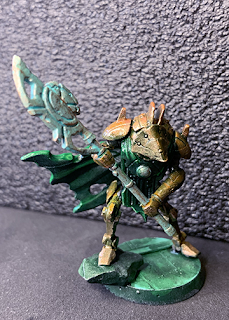Now that I have established what Cruthanarc is and why Cruthanarc is, I have to get to the nitty-gritty of how and why various armies would be trying to kill each other on the surface of a planet nobody wants to be on. A very basic scenario would simply be a troop carrier or similar ship has an accident, gets shot down, or is otherwise forced to land on the surface. This would then unleash the locals to hunt down and find/destroy all the survivors.
While this does have its appeal, it lacks a larger storyline and limits me to always having to put the Infected Colony army on the table. I would much rather have multiple options for all the combatants. This leads me to imagine that the ship that is shot down over Cruthanarc has in its possession some kind of MacGuffin. For those unfamiliar, a MacGuffin is a plot device first used in film. It usually takes the form of an object that is necessary for the motivation of the characters. The kicker is that the MacGuffin is meaningless and insignificant in every other way.
In other words, it really doesn’t matter what was on the ship that breaks apart into multiple pieces as it hits the atmosphere of Cruthanarc. What matters is that it is important enough to several factions off world to risk contracting an incurable disease in order to retrieve it. The fun part of the creative process, especially one where play is concerned, the real nature of the MacGuffin may very well develop as the campaign to retrieve it progresses.
To begin with, I want to start with five such factions, because five fits neatly into a Wu Xing Diagram. Here are the five contenders and how I understand them in context of my version of the Sirius Sector:
- Human Imperium: Originally refugees from a war that destroyed their home world, humanity has quickly spread throughout the sector, becoming one of the most powerful political and military factions in the sector.
- Infected Colonies: A semi-autonomous human colony world that has willingly adopted a ritualized surveillance state in order to monitor an incurable disease that affects everyone who steps on the planet in an attempt to prevent the disease from getting off world.
- Robot Legion: The death-knell of the Elven Empire, this non-biological race nonetheless find themselves resource poor because their home worlds suffered a millennia of elvish decadence.
- Eternal Dynasty: Once an uplifted slave race created by the elves, what is now called the Eternal Dynasty successfully rose up against their masters; however, infighting allowed the elves to drive them out of the Sirius Sector. They have recently returned to Sirius united by a mysterious dynastic force.
- Alien Hive: Believed to be the result of another uplifting experiment, the Alien Hive is a collection of genetic misfits all controlled by a single powerful psychic mind.
Human Imperium
- Friendly: Humans seem to be unusually susceptible to the influence of the Hive Mind. This trait also gives fuel to the Inquisition's anti-alien agenda.
- Enmity: The Eternal Dynasty has proven to be the greatest obstacle to Imperial hegemony in the Sirius Sector.
Infected Colonies
- Friendly: Cruthanarc is dependent upon Imperial help to maintain their self-imposed quarantine.
- Enmity: Given the influence the Hive has on human minds, the more paranoid of the Cruthanarc hierarchy openly wonder if the Alien Hive is the next step in the disease's evolution.
Robot Legion
- Friendly: The Legion admires the rigid social controls that Cruthanarc has developed, it makes them predictable and contained. The Infected Colony is also willing to trade with them, since the robots are incapable of contracting the disease.
- Enmity: The Legion deeply mistrusts biologicals because they are seen as unpredictable and chaotic. The Human Imperium is understood to be the most chaotic and unpredictable biological faction in the Sirius Sector.
Eternal Dynasty
- Friendly: The Dynasty cannot help but have pity for the Robot Legion, since both factions rose up against their elven masters.
- Enmity: Cruthanarc is a key military target in the Dynasty's plan to expand into the Sirius Sector.
Alien Hive
- Friendly: The mysterious power that now unites the warriors of the Eternal Dynasty takes advantage of their latent empathic abilities. The Alien Hive enjoys the presence of these abilities and yet is not driven by a need to dominate them.
- Enmity: The Robot Legion is immune to the Hive Mind and is therefore seen as the Hive's greatest threat.






